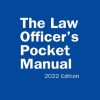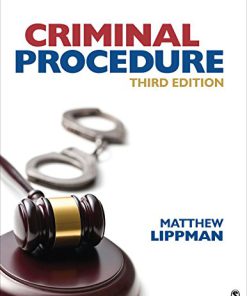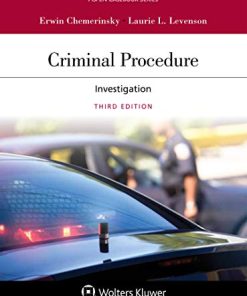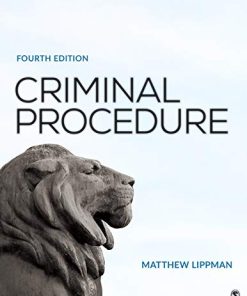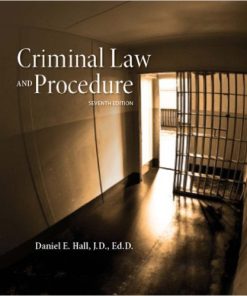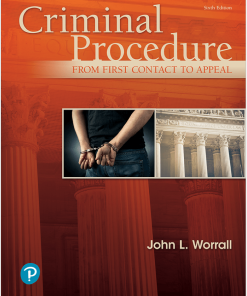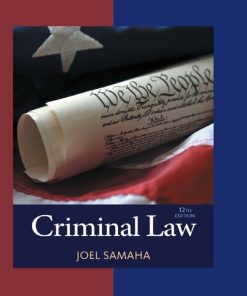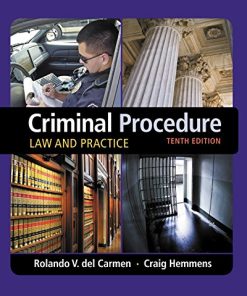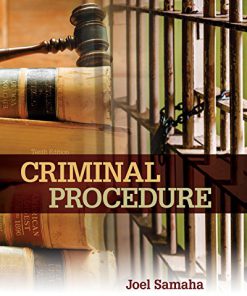Criminal Procedure Law and Practice 10th Edition by Del Carmen, Rolando Hemmens 8214341132 9798214341132
$50.00 Original price was: $50.00.$25.00Current price is: $25.00.
Criminal Procedure: Law and Practice 10th Edition by Del Carmen, Rolando V. Hemmens – Ebook PDF Instant Download/DeliveryISBN: 8214341132, 9798214341132
Full download Criminal Procedure: Law and Practice 10th Edition after payment.
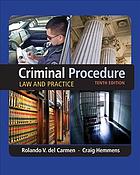
Product details:
ISBN-10 : 8214341132
ISBN-13 : 9798214341132
Author : Del Carmen, Rolando V. Hemmens
Packed with examples from real-world situations faced by today’s law enforcement professionals, CRIMINAL PROCEDURE: LAW AND PRACTICE, 10th Edition gives readers a practical and authoritative look at the most current guidelines in criminal procedure. Comprehensive and accurate without bogging readers down in unnecessary details, the text includes cutting-edge coverage of the law as it relates to arrests, searches and seizures, vehicle stops, use of force, interrogations, and line-ups. It also discusses current topics such as racial profiling, DNA evidence, plea bargaining, seizures of text/email messages, and many others. Interesting case briefs, sample police forms, hypothetical cases, and coverage of the most recent Supreme Court rulings keep the text as relevant as ever. Its clear, reader-friendly presentation makes law enforcement concepts easy to understand and apply.
Criminal Procedure: Law and Practice 10th Table of contents:
Chapter 1. The Court System, Sources of Rights, and Fundamental Principles
The U.S. Court System
The Federal Court System
The State Court System
Where Judicial Decisions Apply
Stare Decisis and Judicial Precedent
Federal versus State Criminal Trials
Jurisdiction versus Venue
Sources of Rights
Constitutions
Statutory Law
Case Law versus Common Law
Court Rules
The Judicial Review Doctrine
The Rule of Law
The Incorporation Controversy
Background
Approaches to Incorporation
A Summary of the Four Approaches to Incorporation
Fundamental Right as the Test for Selective Incorporation
Rights Not Incorporated
The Result of the Incorporation Controversy: “Nationalization” of the Bill of Rights
Court Cases
Case Citation
How to Brief a Case
Summary
Review Questions
Test Your Understanding
Recommended Readings
Chapter 2. Overview of the Criminal Justice Process
The Procedure before Trial
Filing of Complaint
The Arrest
Booking at the Police Station
Initial Appearance before a Magistrate
Setting Bail
The Preliminary Hearing
The Decision to Charge
Indictment versus an Information
The Arraignment
The Plea by the Defendant
Plea Bargains
The Procedure during Trial
The Selection of Jurors
Opening Statement by the Prosecution
Opening Statement by the Defense
Presentation for the Prosecution
Presentation for the Defense
Rebuttal Evidence
Closing Arguments
Defense Motions before the Verdict
Instructions to the Jury
Jury Deliberation
The Verdict
The Procedure after Trial
Imposition of Sentence
Appeal
Habeas Corpus
Procedural Differences in Jurisdictions
Application to Felony Cases
Variation among States
Variation Within a State
Ideal versus Reality
Summary
Review Questions
Test Your Understanding
Recommended Readings
Chapter 3. Probable Cause and Reasonable Suspicion
Probable Cause
Probable Cause Defined (The Legal Definition)
A “Man of Reasonable Caution”
The Practical Definition of Probable Cause
Same Definition of Probable Cause in the Many Areas of Police Work
Arrest of Persons versus Search and Seizure of Property
With a Warrant versus without a Warrant
Why Obtain a Warrant?
Who Determines Probable Cause?
Establishing Probable Cause after an Officer’s Illegal Act
Any Trustworthy Information Can Establish Probable Cause
The Three Ways Whereby Probable Cause Is Established
Probable Cause and Motor Vehicle Passengers
Is an Arrest Based on Probable Cause for a Different Offense Valid?
Reasonable Suspicion
Reasonable Suspicion Defined
The Totality of Circumstances
Probable Cause Compared with Reasonable Suspicion
Determining Probable Cause or Reasonable Suspicion on Appeal
Summary
Review Questions
Test Your Understanding
Recommended Readings
Chapter 4. The Exclusionary Rule
The Exclusionary Rule Defined
The Purpose of the Rule Is to Deter Police Misconduct
A Judge-Made Rule
Historical Development
In Federal Courts
The Rule Now Applies to State Criminal Prosecutions
Invoking the Rule
In Pretrial Motions
On Appeal
In Habeas Corpus Proceedings
Standing and Illegally Seized Evidence
Determining What Is Not Admissible
Illegally Seized Evidence (The Primary Evidence)
Fruit of the Poisonous Tree (The Secondary Evidence)
Exceptions to the Rule
Category 1: The Good Faith Exception and Its Many Variations
Category 2: The Inevitable Discovery Exception
Category 3: The Purged Taint Exception
Category 4: The Independent Source Exception
When the Rule Does Not Apply
In Violations of the Knock-and-Announce Rule
In Searches by Private Persons
In Grand Jury Investigations
In Sentencing
When an Arrest Based on Probable Cause Violates State Law
When Only Agency Rules Are Violated
In Noncriminal Proceedings
In Parole Revocation Hearings
Arguments for the Exclusionary Rule
Arguments against the Exclusionary Rule
Alternatives to the Exclusionary Rule
The Future of the Exclusionary Rule
Summary
Review Questions
Test Your Understanding
Recommended Readings
Chapter 5. Stop and Frisk and Stationhouse Detention
Stop and Frisk
Issue and Origin
The Leading Case
The Guidelines
Reasonable Suspicion Is Required, Not Probable Cause
Two Separate Acts
The Stop
A Case Study: Stops and Race in the New York City Police Department
The Frisk
Stop and Frisk and Arrest Compared
Other Stop and Frisk Applications
Application to Motor Vehicles
Application to Weapons in a Car
Application to Residences
Stationhouse Detention
For Fingerprinting
For Interrogation
Summary
Review Questions
Test Your Understanding
Recommended Readings
Chapter 6. Arrests and Use of Force
The Broad Picture: Arrests Are Seizures of Persons
Arrests and the Fourth Amendment
Arrest Is Just One Form of Seizure
The Top Ten Intrusive Searches and Seizures of Persons
What Is the Legal Test to Determine Whether a Seizure Has Occurred?
Arrest Defined
Forced Detention and Arrest
The Length of Detention and Arrest
The Four Elements of an Arrest
Seizure and Detention
The Intention to Arrest
Arrest Authority
Understanding by the Arrestee
Arrests with a Warrant
When Is a Warrant Needed?
The Issuance of a Warrant
The Contents of a Warrant
The Service of a Warrant
The Time of the Arrest
The Possession and Expiration of a Warrant
Other Legal Authorizations
Arrests Without a Warrant
Felonies Committed in the Presence of Officers
Misdemeanors Committed in the Presence of Officers
Crimes Committed in Public Places
When Exigent (Emergency) Circumstances Are Present
When There Is Danger to the Officer
Entering a Home Without a Warrant
What the Police Can Do after an Arrest
Police Can Search the Arrestee, Including a Strip Search
Police Can Search the Area of Immediate Control
Police Can Search the Passenger Compartment of a Motor Vehicle
Police Can Use Handcuffs
Police Can Monitor the Arrestee’s Movement
Police Can Search the Arrestee at the Place of Detention
Police Can Collect a DNA Sample
What the Police Cannot Do during an Arrest
Police Cannot Enter Third-Party Residences
Police Cannot Conduct a Warrantless Protective Sweep Unless Justified
Police Cannot Invite the Media to “Ride Along”
Knock-And-Announce Is Required by the Constitution, but with Exceptions
The General Rule
The Exceptions
How Long Must the Police Wait before Entering?
Other Arrest Issues
Can the Police Detain a Suspect while Obtaining a Warrant?
Can the Police Arrest for Traffic Violations or Petty Offenses?
Are Arrests for Offenses Not Punishable by Prison or Jail Time Valid?
Are Citizen’s Arrests Valid?
Use of Force during an Arrest
What Governs Police Use of Force?
What the Court Has Ruled in General about Police Use of Force
Nondeadly versus Deadly Force
The Use of Nondeadly Force
The Use of Deadly Force
The Use-of-Force Continuum
Summary
Review Questions
Test Your Understanding
Recommended Readings
Chapter 7. Searches and Seizures of Things
The Fourth Amendment as Applied to Things
The Right to Privacy Is a Constitutional Right
“Reasonable Expectation of Privacy” Defined
Search Defined
Seizure Defined
Searches and Seizures: The General Rule
Things Subject to Search and Seizure
The Scope of the Search
The Time Allowed for a Search
The Procedure after the Search
Search and Arrest Warrants Compared
Search and Seizure with a Warrant
Four Requirements
Probable Cause
A Supporting Oath or Affirmation
A Description of the Place to Be Searched and Persons or Things to Be Seized
The Signature of a Magistrate
The Procedure for Serving a Warrant
Search and Seizure Without a Warrant
The Searches with Consent Exception
The Search Incident to Lawful Arrest Exception
The Exigent Circumstances Exception
The Special Needs beyond Law Enforcement Exception
Public School Searches
Testing Non-College Students for Drugs
Airport Searches
Searches of Probationers and Parolees
The Police and Special Needs
Administrative Searches and Inspections
Warrantless Searches Must Be Contemporaneous
The Announcement Requirement
Other Search and Seizure Issues
The Use of Police Dogs in Searches
Searches and Seizures of Computers
Searches and Seizures of Text Messages in a Cell Phone
Government Seizure of E-mails
Drug Testing Public Employees, Including Police Officers
Searches and Seizures of Public Employees Other than Drug Testing
Squeezing Luggage in a Bus
Searches and Seizures by Private Persons
Searches by Off-Duty Officers
Surgery to Remove a Bullet from a Suspect
Summary
Review Questions
Test Your Understanding
Recommended Readings
Chapter 8. Motor Vehicle Stops, Searches, and Inventories
Vehicle Stops
The General Rule for Stops
What the Police Can Do after a Vehicle Stop
Traffic Stops as Pretexts for Vehicle Searches
Searches with Consent and Freedom to Leave
Passengers Are Also “Seized” in Traffic Stops
Arrests of Vehicle Passengers
Roadblocks Do Not Need Reasonable Suspicion
Vehicle Searches
The Leading Case on Vehicle Searches
The Objective Reasonableness Rule in Vehicle Searches
Automatic Searches during Traffic Citations Are Unconstitutional
Warrantless Vehicle Searches
Police May Search Passenger Compartments
Police May Search Trunks and Closed Packages
Police May Search Containers in a Car
Unresolved: Searches of Locked Trunks or Glove Compartments
Searches When the Arrested Suspect Is Not in the Vehicle—Questions Remain
Other Motor Vehicle Search and Seizure Issues
Searches That Are Not Contemporaneous
Warrantless Searches When There Is Time to Obtain a Warrant
Warrantless Seizures of Vehicles Found in Public Places
Warrantless Searches of Motor Homes
The Use of Electronic Devices to Monitor Vehicles
Immigration and Border Searches of Vehicles
Other Valid Car Searches
Vehicle Inventory Searches
Immediately after an Arrest
Vehicles Impounded by Police
The Importance of State Laws and Department Policies in Vehicle Stops, Searches, and Inventories
Summary
Review Questions
Test Your Understanding
Recommended Readings
Chapter 9. Plain View, Open Fields, Abandonment, and Border Searches
The Plain View Doctrine
Plain View Defined
Requirements of the Doctrine
Situations in Which the Doctrine Applies
One of Many Justifications for Admission of Evidence
Inadvertence Is No Longer Required
Plain View and Open Spaces
Plain View and Motor Vehicles
Plain View and Mechanical Devices
Plain View and Open View Compared
Plain View and Plain Touch Compared
Plain View and Plain Odor Compared
The Open Fields Doctrine
The Open Fields Doctrine Defined
Areas Not Included in Open Fields
Curtilage
A Broader Meaning of Open Fields
Open Fields and Sense-Enhancement Technology
Open Fields and Plain View Compared
Abandonment
Abandonment Defined
Guidelines for When Items Are Considered Abandoned
Abandonment of Motor Vehicles
Police Actions and Abandonment
Abandonment and Plain View Compared
Border Searches
Temporary Detention of Aliens Believed to Be Illegal
Detention of Persons for Questioning in a Border Area
Strip, Body Cavity, and X-Ray Searches
Detention of Alimentary Canal Smugglers
Disassembling the Gas Tank
Searching Vehicles Away from the Border
Stopping Vehicles at Fixed Checkpoints
Factory Survey of Aliens
Summary of Case Law on Border Stops and Searches
Summary
Review Questions
Test Your Understanding
Recommended Readings
Chapter 10. Lineups and Other Means of Pretrial Identification
Lineups
Right to Counsel during Lineups—It Depends
Right to Due Process Applies in Lineups
No Unreasonable Search and Seizure Is Involved in Lineups
No Right against Self-Incrimination Is Involved in Lineups
Showups
Right to Counsel during Showups—It Depends
Right to Due Process Applies in Showups
No Unreasonable Search and Seizure Is Involved in Showups
No Right against Self-Incrimination Is Involved in Showups
Photographic Identifications
No Right to Counsel in Photographic Identification
Right to Due Process Applies in Photographic Identification
No Unreasonable Search and Seizure Is Involved in Photographic Identification
No Right against Self-Incrimination Is Involved in Photographic Identification
Problems with Eyewitness Identification
“Hopelessly Unreliable”
No Prescribed Guidelines
Legislative and Judicial Responses
Eyewitness Identification Guidelines
For Lineups
For Showups
For Photographic Identifications
Other Means of Identifying Suspects
DNA Testing
Polygraph Examinations
Breathalyzer Tests
Handwriting Samples
Hair Samples
Brain Fingerprinting
Facial Recognition Technology
Summary
Review Questions
Test Your Understanding
Recommended Readings
Chapter 11. Confessions and Admissions: Miranda v. Arizona
Before Miranda
Voluntary Confessions
Four Cases Illustrating the Pre-Miranda Voluntariness Test
Miranda Rejects Voluntariness as the Sole Test
The Basics of Miranda v. Arizona
The Case
The Miranda Warnings
Miranda Required by the Constitution, Not Just by Judges
Miranda Must Be Given for All Offenses Except Routine Traffic Stops
Distinguishing Miranda from the Right to Counsel
Miranda May Be Waived Knowingly and Intelligently
When Must the Miranda Warnings Be Given?
When Is the Suspect in Custody?
When Is the Suspect under Interrogation?
Leading Decisions on the Miranda Warnings
Situations That Require the Miranda Warnings
Situations Not Requiring or Not Fully Applying the Miranda Warnings
Situations in Which the Miranda Warnings Are Not Needed
Miranda Cases on Appeal: The Harmless Error Rule
Summary.
Review Questions
Test Your Understanding
Recommended Readings
Chapter 12. Basic Constitutional Rights of the Accused during Trial
The Right to Trial by Jury
Voir Dire
Jury Size
Unanimous versus Nonunanimous Verdicts
Serious versus Petty Offenses
Selecting a Jury of Peers
Disqualification of Jurors Based on Race
Disqualification of Jurors Based on Gender
The Right to Counsel
Why Counsel Is Needed
How Counsel Is Obtained
Automatic Reversal of a Conviction for Denying Defendant a Paid Lawyer
The Responsibility of the Defense Lawyer Is to the Client
The Right to Court-Appointed Counsel during the Trial Has Exceptions
Proving Ineffective Assistance of Counsel Is Difficult
Claims of Ineffective Counsel in Death Penalty Cases
Claim of Ineffective Counsel during Plea Bargaining
The Right to Act as One’s Own Counsel
The Right to Due Process
The Many Meanings of Due Process
The Brady Rule on Disclosure of Evidence to the Accused
Cases after Brady
The Right against Self-Incrimination
The Prohibition Applies Only to Testimonial Self-Incrimination, Not to Physical Self-Incrimination
Testimonial and Nontestimonial Self-Incrimination Compared
Two Separate Privileges during Trial
The Grant of Immunity
Transactional and Use and Derivative Use Immunity Compared
How the Right Is Waived
The Right to a Fair and Impartial Trial
The Prohibition against Prejudicial Publicity
Controlling Prejudicial Publicity
Summary
Review Questions
Test Your Understanding
Recommended Readings
Chapter 13. Sentencing, the Death Penalty, and Other Forms of Punishment
Sentencing
The Goals and Objectives of Sentencing
Sentencing Disparity
When Is a Sentence Considered Cruel and Unusual Punishment?
Sentencing Guidelines
Sentencing Juvenile Offenders
Types of Sentences
The Death Penalty
Imprisonment
Probation
Intermediate Sanctions
Fines, Forfeiture, and Restitution
Crime Victims’ Rights
Victims’ Rights in State Courts
Summary
Review Questions
Test Your Understanding
Recommended Readings
Chapter 14. Legal Liabilities of Law Enforcement Officers
Lawsuits against Police: An Occupational Hazard
An Overview of Police Legal Liabilities
Civil Liability under Federal Law
What Section 1983 Provides
Two Requirements for a Section 1983 Lawsuit to Succeed
Defenses in Section 1983 Cases
Civil Liability under State Tort Law
Types of State Tort Cases
Other Sources of Police Civil Liability under State Tort Law
Official Immunity Is a Defense in State Tort Cases
Federal (Section 1983) and State Tort Cases Compared
Differences between Federal Section 1983 and State Tort Cases
If the Police Are Sued
The Police Officer as Defendant
The Police Supervisor as Defendant
The City or County as Defendant
Other Consequences of Police Misconduct
Prosecution under Federal and State Laws
Administrative Liability: Agency Investigation and Punishment
Exclusion of Illegally Obtained Evidence (The Exclusionary Rule)
Loss of Law Enforcement License
Summary
Review Questions
Test Your Understanding
Recommended Readings
Chapter 15. Electronic Surveillance and the War on Terror
Electronic Surveillance
The Old Concept
The New Concept
Four Federal Laws That Govern Electronic Surveillance
Title III of the Omnibus Crime Control and Safe Streets Act of 1968
The Electronic Communications and Privacy Act (ECPA) of 1986
The Communications Assistance for Law Enforcement Act (CALEA) of 1994
The Foreign Intelligence Surveillance Act (FISA) of 1978
Using Electronic Devices from a Public Place
Electronic Tracking Devices That Do Not Intercept Communication
Pen Registers
Tracking Devices
Cameras to Monitor Tracking and Other Offenders
The War on Terror
The USA PATRIOT Act
The Department of Homeland Security
Terrorism and the Police
Legal Issues in the War on Terror
Prospects
Summary
People also search for Criminal Procedure: Law and Practice 10th:
federal rules of criminal procedure
rules of court criminal procedure
code of criminal procedure 1898
section 205 of the criminal procedure act
texas code of criminal procedure
Tags: Criminal Procedure, Law, Practice, Del Carmen, Rolando Hemmens
You may also like…
Social Science
Uncategorized
Jurisprudence & Law - Criminal Law & Procedure
(EBOOK PDF)Criminal Law 12th Edition by Joel Samaha 9781305577381 1305577388 full chapters
Uncategorized
Uncategorized



